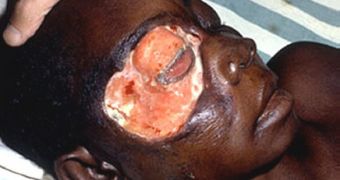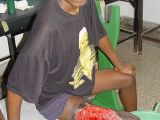When the Buruli ulcer, nasty flesh-eating eruptions of Mycobacterium ulcerans, broke out in Ivory Coast a decade ago, two French green clays worked best, removing the specter of surgery or amputation. One clay induced excruciating pain, but in several days it induced skin tissue regeneration on the open wound. A second variety, mixed with shea butter (a plant oil), induced no pain and cured the oozing ulcer in several months. In France, these iron-rich clays have been used for centuries.
Now a team led by mineralogist Lynda Williams of Arizona State University (A.S.U.) in Tempe has been attempting to explain the healing powers of the French clays.
"This clay was unique in that they were very small particle size, 200 nanometers, or 1/400 the width of a human hair," said Williams.
The producer companies (Agriletz and Agricur) did not expose the source of the clays, but French mineralogists guess they are made of volcanic ash deposits from the French Massif Central.
First tests were made on Escherichia coli, the all-over present food infecting bacteria, but after that on all kinds of bacteria, from Salmonella to antibiotic-resistant Staphylococcus aureus.
"That's when we first discovered that the first clay promoted bacterial growth and the second killed it," said Wiliams. "The strains that we are using are the same ones that pharmaceutical companies use to test their antibiotics. All of the gram-negative pathogenic bacteria to humans that we've tested, we can kill completely." said co-author Shelley Haydel, A.S.U. microbiologist.
Like many antibiotics, the clay stopped the reproduction of those bacteria it could not kill.
"The number of cells we start with is 107 Staphylococcus aureus. After 24 hours, that level reduces tenfold." said Haydel. But the tests have not solved the puzzle: how do they do it? Chemical analysis found no particular minerals or metals in the clay explaining the antibacterial powers and added water did not affect this effect.
The killing powers were preserved even when the clays were heated to over 1,000o F (550o C), but lost over 1,650o F (900o C), when the clay's structure was affected, leaving behind only the heaviest elements, like radioactive cesium, selenium and toxic arsenic. "E. coli can tolerate 200 parts per million and we're talking about 50 ppm. The clay's antibacterial effect appears to be chemical rather than physical, because its strength diminishes as it loses positively charged molecules and it does not smother the bacteria or cause its cell walls to burst. After six hours, you can see a [bacterial cell] surface that is kind of wormy or grainy. It doesn't look like something is precipitating at the surface. Maybe something is going into the cell and damaging it that way." said Williams.
The clay could combine the antibacterial powers of its many various elements.
"I think these clays are buffering water to keep whatever's toxic to bacteria in there. If we remove the clay from water, I think it's not going to work." said Williams.
The age also affects the clays' power.
"We went back and got some from the same batch and it didn't kill. This clay has been sitting outside in a pile for 10 years. It could have oxidized and maybe the oxidation state has affected the antibacterial properties." said Williams. Two other clays with similar antibacterial powers have been detected.
"They're all different mineralogically, though they have a general structure in common. We're trying to compare the properties of these antibacterial clays and see what's going on." said Williams.
Researchers do not neglect the variant that clays could boost the human immune system reaction to the infection, which M. ulcerans can inhibit.
"Even if you removed the antibacterial properties, do the clays have any effect on wound healing? What is the body's response? Are you stimulating tissue regeneration? We already use maggots and leeches in hospitals. Why don't we use clays?" said Haydel.

 14 DAY TRIAL //
14 DAY TRIAL // 
